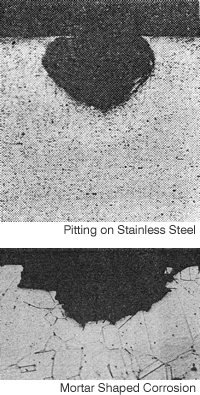"Localized Corrosion" is a term to describe a type of corrosion along with "Full Surface Corrosion", and indicates a type of corrosion where metal erosion occurs on localized areas as the term describes. The causes for that are thought to be (1) nonuniform metal composition, and (2) nonuniform corrosive environment.
A representative example for the case of nonuniform metal corrosion is "Contact Corrosion of Unequal Metals". For example, when a small piece of copper is placed on a steel plate and exposed to a corrosive environment, the copper hardly corrodes but a concentrated corrosion occurs on steel where contacting the piece of copper.
Additionally, when a welded steel is left submerged in water, corrosion occurs at weldments. This occurs because the metal property of weldments has changed from the base steel due to the welding process. This is a type of Contact Corrosion of Unequal Metals, but since the metal type is the same, it is called "Selective Corrosion of Weldments".
A representative example of Nonuniform Environment Corrosion is a case for bulkhead steel plates for shoreline protection. The waterline areas of these steel plates are severely corroded whereas the other parts of the plates are not. This is because the waterline areas are submerged during the high tides, and exposed to the air during the low tides. It can be said that the waterline areas and the other areas of the steel plates are subjected to nonuniform corrosive environments. In water, the differences in dissolved oxygen levels cause localized corrosion.
|
Localized corrosion also causes holes. A small opening diameter but deep corrosion is called "Pitting". For carbon steels, wide opening but shallow "dish or mortar shaped" corrosion occur often. For passive surfaced metals such as stainless steel, pitting occurs. The reason for that is thought to be the following. Passivated metals have several nanometers thick of highly corrosion resistant passive layer on the surface, and normally do not corrode in air and water. But if enough chlorine ions exist in the environment (i.e. sea water) this passive layer can be broken and nonuniform conditions will promote the advancing of the corrosion, thus pitting occurring. |
 |
